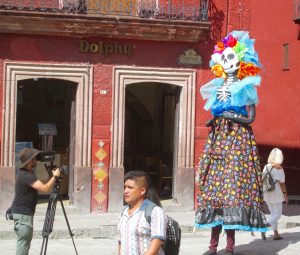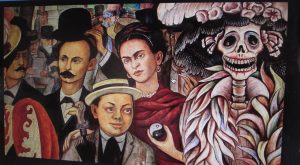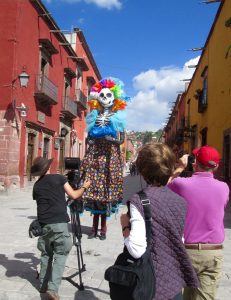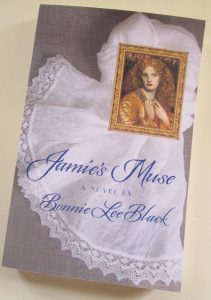La Catrina – that tall, skinny (well, she’s a skeleton) woman dressed in flouncy clothes and wearing a rakish, plumed, wide-brimmed hat – has been called “Mexico’s grand dame of the dead.” You see her and her look-alikes everywhere here in San Miguel de Allende these days.

Yes, it’s that time of year again, when all the skeletons come out of their closets (or wherever they’ve been sleeping) to bring joy and meaning to locals and tourists alike. The Days of the Dead – October 31, through November 2 – are days of celebration, when dearly departed friends and family members are remembered and honored. Altars are erected to their memory. Their favorite foods and drink are laid out for them. Their favorite music played.
This idea at first strikes most of us gringos as astonishing: In Mexico death isn’t frightening; it’s considered part of a natural, normal progression. All those Catrinas sashaying around seem to symbolize this. They’re dressed up as if for a grand fiesta. They’re smiling as if they know a secret. They dance like only a skeleton can.
According to my online research, the concept of La Catrina originated around the turn of the last century, when Porfirio Diaz was president of Mexico. Printmaker Jose Guadalupe Posada first made the image of Catrina for an engraving published in 1913. Posada wanted to create a skeleton dressed extravagantly and elegantly to depict the Mexican women of the upper class during that era.
Diego Rivera later popularized the image in his 1946 mural Sueño de una tarde dominical en La Alameda Central (Dream of a Sunday Afternoon in Alameda Park).

I read somewhere once that at this time of year – the end of October into early November – the membrane between this world and the next is the most porous. Which is why people all over the world have always felt the need in this season to acknowledge the spooky. Leave it to the happy-go-lucky Mexicans, though, to turn the occasion into a party.
Those of us who have lived in Mexico a while like to get in on the act, too — if not to actually dress up like a Catrina (or her suave partner), have our faces painted like skeletons, and swish around town, as some gringos do, then at least by building quiet little altars to our dead loved ones in our homes.
Here is the altar I just made to my paternal grandparents, John and Jessie Black. Jessie died before I got to know her, but John died on Halloween Day, 1954, when I was nine. We kids called him Pop. He was a good man. I loved him.

In this old, black-and-white photo, John and Jessie are newlyweds in their twenties; they are both Scottish immigrants to the United States who settled in Morristown, New Jersey. The flowers on the right of this picture are marigolds, the traditional flowers displayed during the Days of the Dead because their vibrant color and pungent scent are believed to guide the spirits to their altars. And there on the lower left is a Catrina skull. Smiling, of course.
My new book, Jamie’s Muse, is the imagined, dramatic story of my great-grandmother, John Black’s mother, Helen Reid David Black of Kirriemuir, Scotland, who died young in Natal, South Africa, in or around 1885, under mysterious circumstances. (For more on this story, go to www.bonnieleeblack.com .) Without a photo of her, I’ve only been able to imagine her face as resembling that of Dante Rossetti’s famous painting of Helen of Troy, which is featured on the book’s cover:
As the delightful Academy Award-winning animated film “Coco,” set during Mexico’s Days of the Dead, shows, this is a joyful time of year, a time to celebrate both the living and the dead. And to remember: We’ll all be Catrinas one day.


